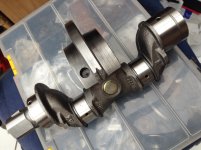Bingo. yes right now im running a 70x70 engine. Stock crank stroke, forged con-rods, but 540cc cylinders which is 70mm bore Which makes it a square engine. Performance has been somewhat inconsistent, but im working thru it, i haven't given up the effort on trying to wrangle in the weber ich 32 carb. I believe my issue is, that the carb is slightly too large for the engine displacement, and causing me grief with tuning.I do have a few plan B's and C's come this spring.
The 40/80 cam, does seems to really liven up past 3000 rpm, and the engine really wants to rev. But it does seem to somewhat fall flat on its face below 3000. Having a lower displacement for such a sporty cam i believe isn't doing me much of a favor. Having a larger displacement will definitely help in keeping intake flow velocities high, and hopefully smooth out these weird power bands i am having. In a few months once i have the time, i will have flow bench values for all to see how a stock head compares to a modified head and so on. We can then make conclusions from there on in.
Gear ratios also make a big difference in drive ability. I always found that i was running out of gears on the stock setup, mine being iirc 8/41 final ratio.. I just ordered a 9/39 final drive to help lengthen first gear, and drop cruising rpm's without having to go 5 speed yet. I wont say the car is a dog, it does get up and go somewhat over a stock 500. But having driven Toms car for a short sprint with this massaged peppy 594cc engine even with 2 of us in the car, its night and day, i still have work to do on mine to get remotely close lol.
In the past i might have mentioned that i had plans for a much larger engine. I have a few 126 engine blocks and "planning" to do a big bore stroker engine. 82mm bore. with either a 76 or 80mm stroke crank. Unfortunately trying to hunt down the crank has been a journey. Yes they do exist, but options are limited, and info/feedback about them is sparse. Balancing is also another aspect/adventure. In Europe and the UK it might not be very difficult to find someone who can balance a parallel twin crank properly, in North America no one has a clue about them. The real trick is finding someone who knows what proper "balance factor" to use on these engines. Technically they are balanced to a desired rpm range and use case. And you need to already have the piston, rings, con-rods already to weigh and do accruate calculations.
I am trying to hunt down a forged 76 or 80 mm stroke crank for my 2nd engine. With that for now, a twin duct modified panda 30 head with larger valves will be the go too for its first variant.
To close, i would say the trade off with a longer stroke is peak RPM. But that tradeoff also is based upon the crank strength, and "balance". I would assume those insane high powered hill climb 500's that are revving to the moon (7000+rpm), are more then likely running a variant of a stroker crank and big bore kit, and those engine are absolutely singing up the Italian hillsides. A high revving 500 engine is definitely a treat with the proper exhaust




